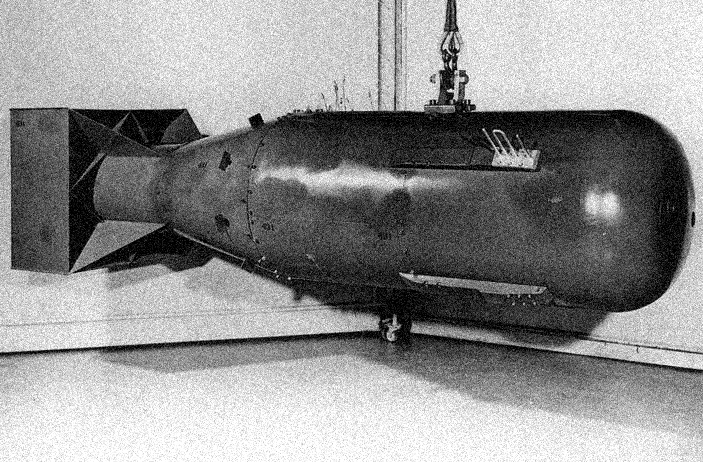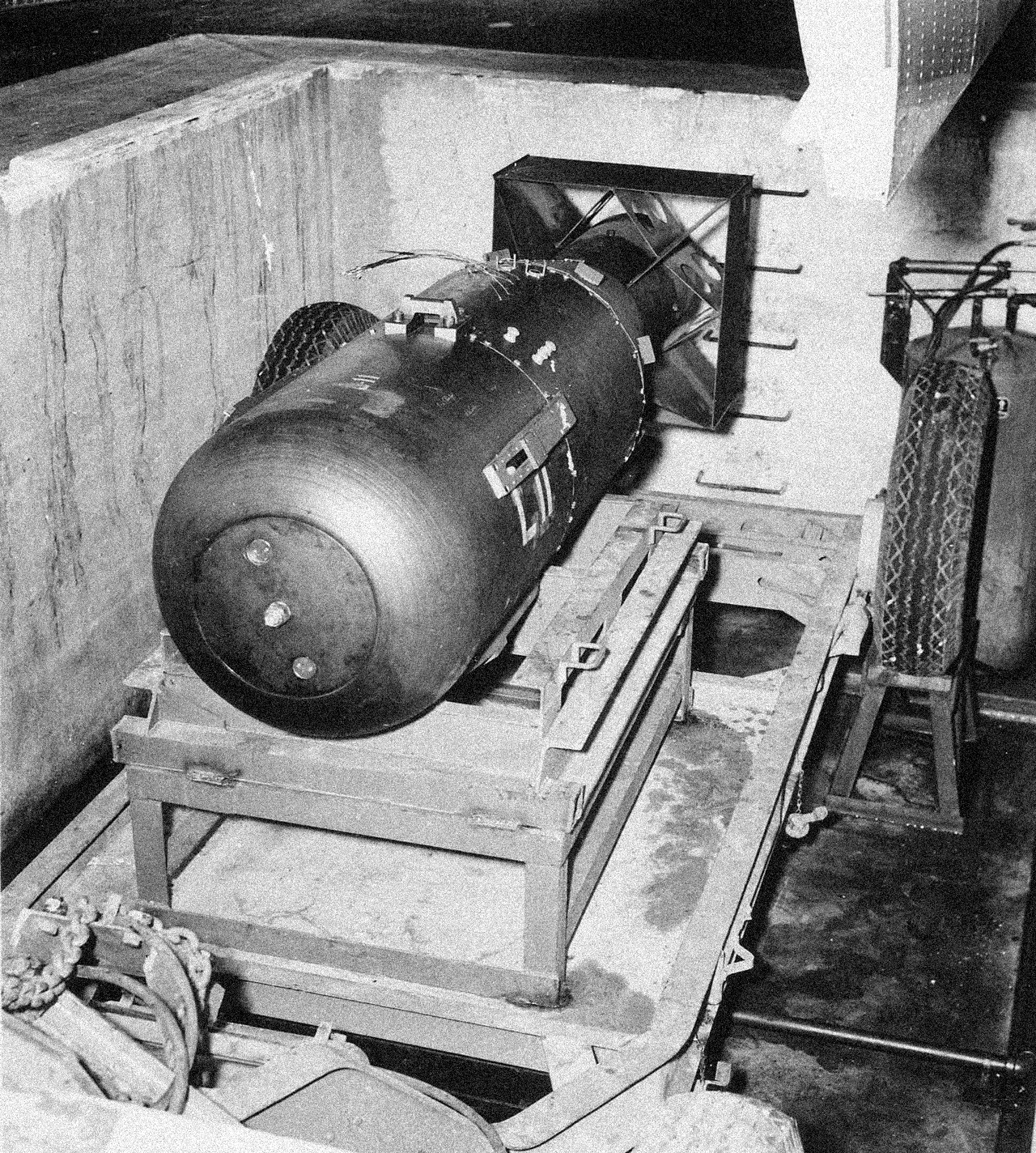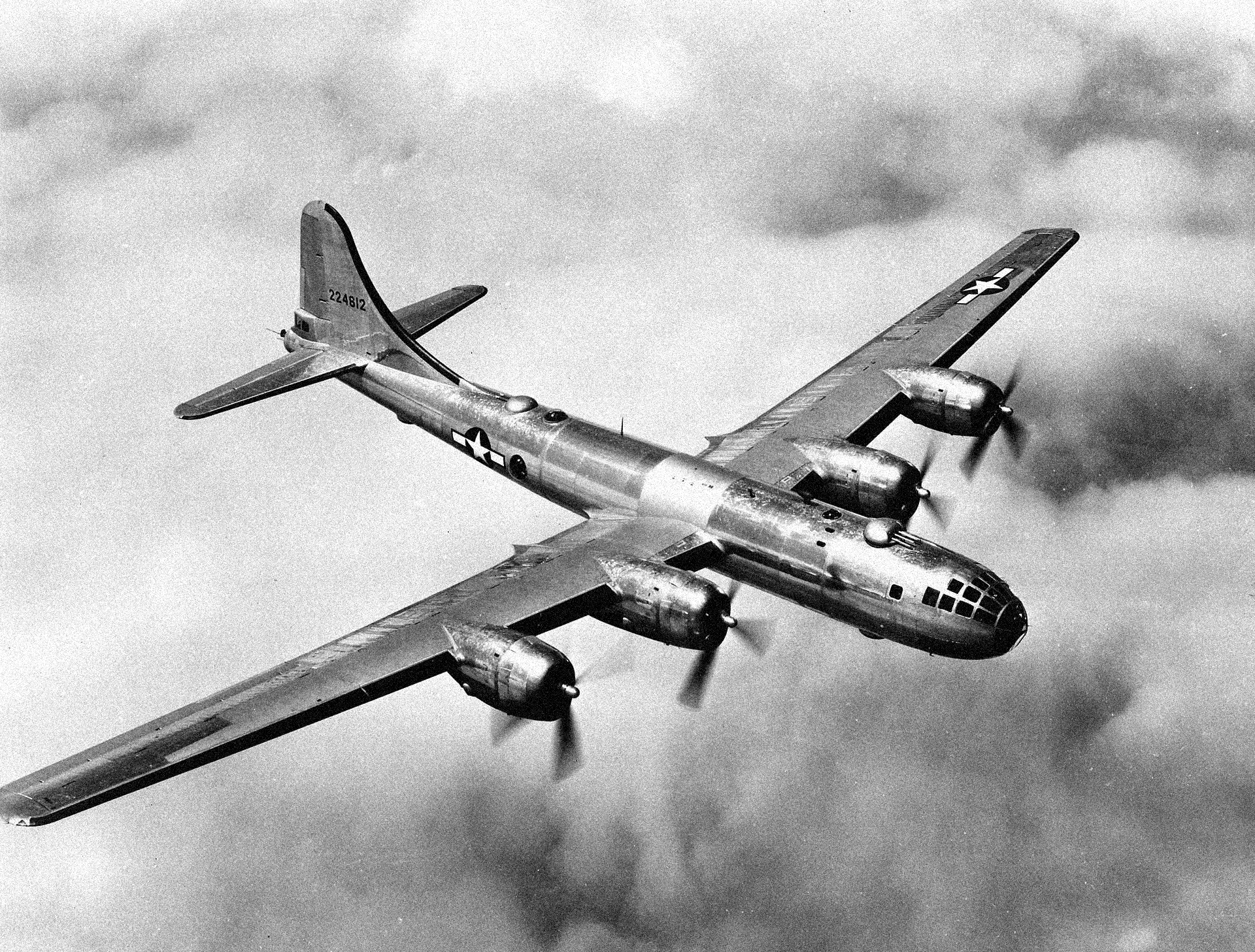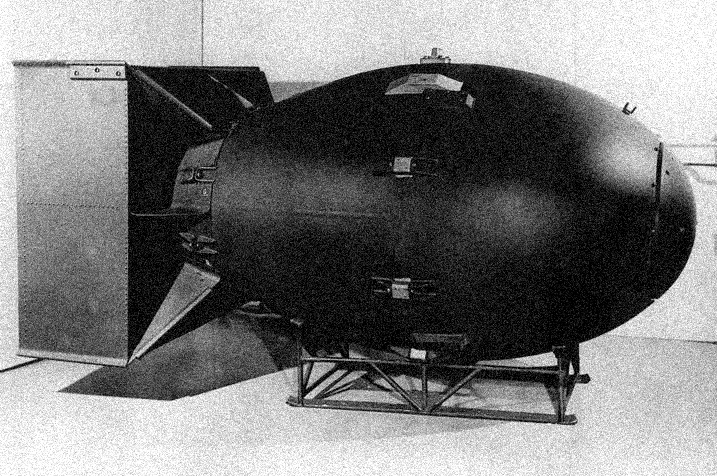LITTLE BOY

NUCLEAR WEAPON
“THE BOMBING SAVED LIVES BY EDING THE WAR MORE QUICKLY AND WITHOUT A LAND INVASION.”

DESIGN
The Little Boy was 120 inches (300 cm) in length, 28 inches (71 cm) in diameter and weighed approximately 9,700 pounds (4,400 kg). The design used the gun method to explosively force a hollow sub-critical mass of uranium-235 and a solid target cylinder together into a super-critical mass, initiating a nuclear chain reaction. This was accomplished by shooting one piece of the uranium onto the other by means of four cylindrical silk bags of cordite. The bomb contained 64 kg (141 lb) of enriched uranium. Most was enriched to 89% but some was only 50% uranium-235, for an average enrichment of 80%. Less than a kilogram of uranium underwent nuclear fission, and of this mass only 0.6 g (0.021 oz) was transformed into several forms of energy, mostly kinetic energy, but also heat and radiation.
ASSEMBLY DETAILS
Inside the weapon, the uranium-235 material was divided into two parts, following the gun principle: the "projectile" and the "target". The projectile was a hollow cylinder with 60% of the total mass (38.5 kg (85 lb)). It consisted of a stack of 9 uranium rings, each 6.25-inch (159 mm) in diameter with a 4-inch (100 mm) bore in the center, and a total length of 7 inches (180 mm), pressed together into the front end of a thin-walled projectile 16.25 inches (413 mm) long. Filling in the remainder of the space behind these rings in the projectile was a tungsten carbide disc with a steel back. At ignition, the projectile slug was pushed 42 inches (1,100 mm) along the 72-inch (1,800 mm) long, 6.5-inch (170 mm) smooth-bore gun barrel. The slug "insert" was a 4 inches (100 mm) cylinder, 7 inches (180 mm) in length with a 1 inch (25 mm) axial hole. The slug comprised 40% of the total fissile mass (25.6 kg or 56 lb). The insert was a stack of 6 washer-like uranium discs somewhat thicker than the projectile rings that were slid over a 1 inch (25 mm) rod. This rod then extended forward through the tungsten carbide tamper plug, impact-absorbing anvil, and nose plug backstop, eventually protruding out of the front of the bomb casing. This entire target assembly was secured at both ends with locknuts. When the hollow-front projectile reached the target and slid over the target insert, the assembled super-critical mass of uranium would be completely surrounded by a tamper and neutron reflector of tungsten carbide and steel, both materials having a combined mass of 2,300 kg (5,100 lb). Neutron initiators at the base of the projectile were activated by the impact.
- Front nose locknut
- 15" diameter steel nose plug forging
- Target case forging
- K-46 Steel target liner sleeve
- Impact absorbing anvil
- Tungster-Carbide tamper plug
- Polonium-Beryllium initiators (4)
- U-235 target rings (6)
- Tungten-Carbide ta,per cylinder sleeve
- Yagi antenna assembly (4)
- Target case gun tube adapter
- Lift lug
- Safing/Arming plugs
- 6.5" Bore gun tube
- Electrical plugs
- Baro ports (8)
- Armored Tube w/ primer wiring (3)
- Alignment rod (3)
- U-235 projectile rings (9)
- Projectil Tungsten-Carbide disk
- Projectil steel back
- Gun tube reinforcing sleeve
- Cordite powder bags (4)
- Gun breech w/ removable inner plug
- Mark XV electric gun primers (3)
- Armor Plate
“THEY WON’T QUIT SO WE MUST USE THE BOMB, IT WILL SAVE MANY AMERICAN AND JAPANESE LIVES TO DO SO”

FAT MAN

NUCLEAR WEAPON
“WE DROPPED TWO BOMBS, THUS ENDING THE WAR”

BOMB INTERIOR
The bomb was 128 inches (3,300 mm) long and 60 inches (1,500 mm) in diameter. It weighed 10,300 pounds (4,700 kg).
- 1773 EBW Detonators inserted into brass chimney sleves (32)
- Comp B component of outer lens (32)
- Cone-shaped Baratol component of outer lens (3)
- Comp B inner charge (32)
- Removable aluminum pusher trop-door plug screved into upper pusher hemisphere
- Aluminum pusher hemispheres (2)
- Tuballoy (U-238) two-piece tamper plug
- Pu-239 hemispheres (2).
- Cork Lining
- 7-piece Duralumin sphere
- Aluminum cups holding pusher hemispheres together (4)
- Polonium-Beryllium initiator
- Tuballoy (U-238) temper shpere
- Boron plastic shell
- Felt padding layer under lenses and inner charges

“THE BOMBING SAVED LIVES BY EDING THE WAR MORE QUICKLY AND WITHOUT A LAND INVASION.”
ASSEMBLY DETAILS
To allow insertion of the 3.62-inch (92 mm) diameter plutonium pit, containing the 0.8-inch (20 mm) diameter "Urchin" modulated neutron initiator, as late as possible in the device's assembly, the spherical 8.75-inch (222 mm) diameter depleted uranium tamper surrounded by a 0.125-inch (3.2 mm) thick shell of boron impregnated plastic had a 5-inch (130 mm) diameter cylindrical hole running through it, like the hole in a cored apple. The missing tamper cylinder, containing the pit, could be slipped in through a hole in the surrounding 18.5-inch (470 mm) diameter aluminium pusher. The pit was warm to touch, emitting 2.4 W/kg-Pu, about 15 W for the 6.19 kilograms (13.6 lb) core. The explosion symmetrically compressed the plutonium to twice its normal density before the "Urchin" added free neutrons to initiate a fission chain reaction.



























